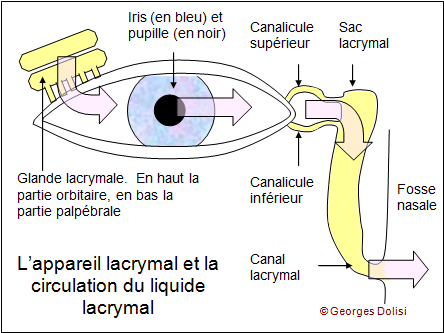Dacryocystitis is an inflammation of the tear sac (dacryocyst), which is located in the inner corner of the eye, near the nose. It is usually caused by a blockage of the tear duct, which prevents tears from draining properly, leading to infection and inflammation.

Causes of Dacryocystite
Dacryocystite is often caused by the following factors:
- Tear Duct Blockage: The tear duct can become blocked by mucus buildup or bacterial infections, which block the drainage of tears.
- Infections: Usually caused by bacteria such as Staphylococcus aureus or Streptococcus pneumoniae that enter the tear sac.
- Chronic inflammation or infection of the tear ducts.
- Congenital abnormalities: Sometimes a blockage of the tear duct can be present from birth.
- Age: In older adults, weakened tear ducts may be more likely to lead to blockages.
Symptoms of Dacryocystitis
The symptoms of dacryocystite can vary depending on the severity of the inflammation:
- Redness and swelling in the inner corner of the eye
- Pain or tenderness in the area around the tear sac
- Pus or discharge from the inner corner of the eye
- Tears or a watery eye due to a blockage of the tear duct
- Fever (in cases of more serious infection)
Treatment of Dacryocystite
Treatment for dacryocystite depends on the severity of the condition:
- Antibiotics: For a bacterial infection, antibiotic eye drops or systemic antibiotics are often prescribed to treat the infection.
- Tear Sac Massage: In mild cases, massaging the tear sac may help to clear the blockage.
- Surgery: If the infection is recurring or if the tear duct is completely blocked, surgery may be necessary to clear the blockage. This may include a dacryocystorhinostomy (DCR), which creates a new drainage duct for the tears.
- Warm compresses: Applying warm compresses to the affected area can help relieve inflammation and promote the healing process.
Complications
If left untreated, dacryocystite can lead to more serious complications such as:
- Abscess formation: The infection may spread and form an abscess (collection of pus), which may require surgery.
- Chronic infection: Recurrent infections can permanently damage the tear duct, causing permanent obstruction.
- Spread of infection: In rare cases, the infection can spread to other parts of the eye or even to surrounding structures.
Prevention
Prevention of dacryocystite includes:
Avoid Smoking: Smoking can contribute to weakened tear ducts, so quitting smoking can reduce your risk.
Hygiene: Clean the eye regularly to prevent build-up of dirt or mucus.
Treatment of underlying conditions: Addressing other eye problems or infections that may be blocking the tear duct.